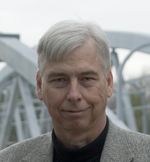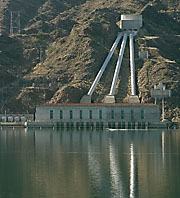 I would like to use this space to tell a few stories about the writing of Infrastructure—the writing and also, especially, the photographing. For 15 years, it was my way of life. Every few months, I would take off on a long road trip, with a car full of cameras and tripods and other gear. When I traveled for other reasons, I always had a camera with me, and I usually tacked a few extra days onto the end of the trip so I could go out in search of interesting infrastructure—the fire hydrants of San Diego, the manhole covers of New Orleans, the barbed-wire fences of Kansas. My traveling companions learned to put up with sudden, unplanned stops and detours.
I would like to use this space to tell a few stories about the writing of Infrastructure—the writing and also, especially, the photographing. For 15 years, it was my way of life. Every few months, I would take off on a long road trip, with a car full of cameras and tripods and other gear. When I traveled for other reasons, I always had a camera with me, and I usually tacked a few extra days onto the end of the trip so I could go out in search of interesting infrastructure—the fire hydrants of San Diego, the manhole covers of New Orleans, the barbed-wire fences of Kansas. My traveling companions learned to put up with sudden, unplanned stops and detours.
On my solitary road trips, I developed a routine. Every morning I would pack up the car and head out early, hoping for good light. Sometimes I had a specific destination in mind, but more often I was just wandering. When some artifact caught my eye—an unusual cell-phone tower, an electrical substation, a handsome railroad hopper car—I would get off the highway, circle around, and try to find the right spot for making a picture. Toward the end of the afternoon, as the light faded, I would look for a motel. I spent the evenings writing up notes on what I had seen. In later years, when I began working with digital cameras, I was able to upload the photos to a laptop and start sorting and annotating them on the spot.
In a sense, Infrastructure is my personal photo album. When I look at the pictures, I see things no one else does; for me the images summon to mind not just the object being documented but also the occasion when the picture was made.  The photograph at right shows the pumping station that draws water out of the Colorado river and lifts it over the mountains to the city of Los Angeles. It's just some pumps and pipes, but I can't look at the photo without remembering what I went through to get that picture—lugging my equipment across a few miles of rough terrain, hacking through brambles near the shorline, scaling a rocky ledge to find the right angle, and then doing it all again the next day when I decided that what the shot really needed was morning light.
The photograph at right shows the pumping station that draws water out of the Colorado river and lifts it over the mountains to the city of Los Angeles. It's just some pumps and pipes, but I can't look at the photo without remembering what I went through to get that picture—lugging my equipment across a few miles of rough terrain, hacking through brambles near the shorline, scaling a rocky ledge to find the right angle, and then doing it all again the next day when I decided that what the shot really needed was morning light.
 At left is a cargo ship of a type known as a RoRo (for "roll-on, roll-off"), taking on a load in the harbor of Sorrento, Italy. I happened to notice the ship as I was driving past on the autostrada high above the city. There was a parking area that would offer a perfect view, but it was accessible only from the other side of the highway. So I got off at the next exit, paid my toll, made a U-turn, paid another toll to the same collector and headed back the way I'd come—and then I missed the ramp for the parking area. So I made two more U-turns and paid four more tolls. The last time I handed over a euro coin, the collector gave me a funny look and said something I wish I could have understood.
At left is a cargo ship of a type known as a RoRo (for "roll-on, roll-off"), taking on a load in the harbor of Sorrento, Italy. I happened to notice the ship as I was driving past on the autostrada high above the city. There was a parking area that would offer a perfect view, but it was accessible only from the other side of the highway. So I got off at the next exit, paid my toll, made a U-turn, paid another toll to the same collector and headed back the way I'd come—and then I missed the ramp for the parking area. So I made two more U-turns and paid four more tolls. The last time I handed over a euro coin, the collector gave me a funny look and said something I wish I could have understood.
A few of the photos in Infrastructure were made with the permission and assistance of the owners of the facilities being illustrated; if I wanted to see inside a steel mill or an oil refinery, that was the only choice. Most of the photos, though, were made from "outside the fence," where I was seeing only what any other member of the public could see. (A fair number were made through the fence.) A few more were made from behind the wheel of a moving car. For aerial photos, I chartered a plane on one occasion, but all the other aerial photos were made through the windows of commericial airlines on ordinary flights.
Understandably, not everyone is happy to see a stranger by the roadside setting up a camera and pointing a telephoto lens their way. Many times, a guard or a foreman would come ask what I was up to. With a few exceptions, these encounters came out happily. I explained the nature of my project, and even if they didn't quite believe my story, they were friendly, and they answered my questions. A couple of times, I was even invited in for a better look. After September 11, 2001, however, photographic expeditions became a high-anxiety experience. The Attorney General was warning the public to be on the lookout for people taking pictures of refineries or chemical plants or bridges—a warning that seemed to be directed squarely at me. In the end I was able to complete the book without being arrested or even challenged by the police, but at times I did feel like a suspicious character.
More about Brian Hayes
I've been a science writer for more than 30 years, mostly focusing on topics in mathematics and computation. Since 1990 I've been affiliated with American Scientist, the magazine of Sigma Xi, the Scientific Research Society. For a few years I was editor of the magazine; since then I have been Senior Writer, producing a bimonthly column titled Computing Science. More recently, I've also been writing a weblog called bit-player that covers some of the same territory as the column.
In earlier years I was an editor (and briefly also a columnist) at Scientific American.
How to reach me
- email: brian@bit-player.org
- postal: 11 Chandler St. #2, Somerville MA 02144, USA